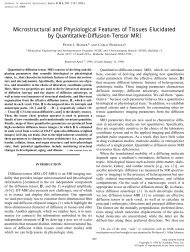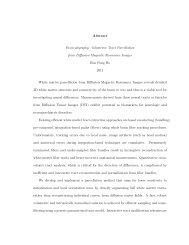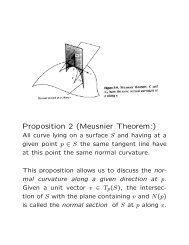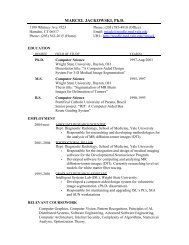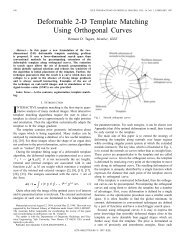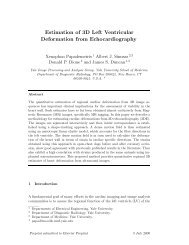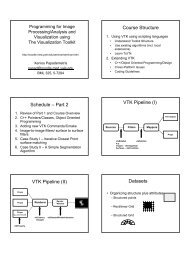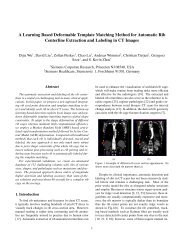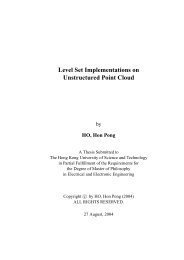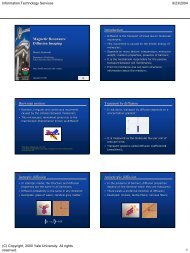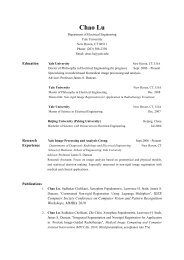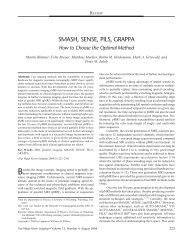Pulsed-field gradient nuclear magnetic resonance as a tool for ...
Pulsed-field gradient nuclear magnetic resonance as a tool for ...
Pulsed-field gradient nuclear magnetic resonance as a tool for ...
You also want an ePaper? Increase the reach of your titles
YUMPU automatically turns print PDFs into web optimized ePapers that Google loves.
328<br />
PRICE<br />
Figure 10 A plot of the simulated echo attenuation <strong>for</strong> PFG diffusion me<strong>as</strong>urements in a<br />
cylinder with the cylinder oriented at three different polar angles with respect to the<br />
<strong>gradient</strong>, i.e., 0 Ž . , 4 Ž . , and 2 Ž . versus calculated<br />
using Eqs. 92 , 110 , and 112 ,<br />
respectively. Also shown is the result of a power distribution<br />
of polar angles Ž . versus calculated using Eqs. 110 and 119 .<br />
The parameters used<br />
in the simulation were the same, <strong>as</strong> far <strong>as</strong> possible, <strong>as</strong> those used <strong>for</strong> the sphere in Fig. 7, i.e.,<br />
1 ms, D 5 1010 m2s1 , g 1Tm1 ,R8m, L 24 m, and 1H <br />
2.6571 10 8 rad T 1 s 1 . The effects of the polar angle can be clearly seen on the<br />
attenuation curves, and the curves go through three stages depending on Žthis<br />
is most<br />
obvious in the 2 c<strong>as</strong>e . , similar to the results <strong>for</strong> diffusion in a sphere Ž see Fig. 7 . . As<br />
would be expected, since it is an average over all possible polar angles, the powder average<br />
echo-attenuation curve is between the limits of the attenuation curves <strong>for</strong> 0 and<br />
2. Because of the axial symmetry of the cylinder, it w<strong>as</strong> unnecessary to average over<br />
. However, the normalization factor in Eq. 119 w<strong>as</strong> changed appropriately.<br />
For example, it makes it difficult to compare the<br />
diffusional characteristics of one sample to another.<br />
A solution is to determine D itself by<br />
me<strong>as</strong>uring the diffusion coefficients in seven different<br />
directions i.e.,<br />
except <strong>for</strong> the c<strong>as</strong>e of<br />
charged moieties, D is symmetric Ž 118. and so<br />
there are only six independent elements .<br />
However,<br />
because of experimental imprecision it is<br />
normal to per<strong>for</strong>m a much larger number of<br />
me<strong>as</strong>urements and determine D statistically<br />
Ž 114 . . As seen in Eq. 108 ,<br />
the use of a single<br />
<strong>gradient</strong> direction in a diffusion me<strong>as</strong>urement<br />
allows the diagonal elements of D to be probed.<br />
The off-diagonal elements can be probed by applying<br />
<strong>gradient</strong>s along various oblique directions<br />
Žconsider the pulse sequence shown in Fig. 2, but<br />
with the possibility of <strong>gradient</strong>s along all three<br />
.<br />
Cartesian directions . For example, if <strong>gradient</strong>s<br />
were applied along all three Cartesian directions,<br />
then the echo attenuation would be described by<br />
Ži.e., Eq. 105. Ž .<br />
ln E b D b D b D<br />
xx xx yy yy zz zz<br />
Ž . Ž .<br />
b b D b b D<br />
xy yx xy xz zx xz<br />
Ž . <br />
b b D . 117<br />
yz zy yz<br />
As a further complication, the restricting geometries<br />
may not all be uni<strong>for</strong>mly aligned in the<br />
same direction e.g., brain white matter Ž 119. or<br />
even randomly aligned Že.g.,<br />
a suspension of red<br />
blood cells . . The apparent D is then an average<br />
of the different orientations. Me<strong>as</strong>uring diffusion<br />
in three orthogonal directions so <strong>as</strong> to determine<br />
the trace of the diffusion tensor h<strong>as</strong> been pro-



